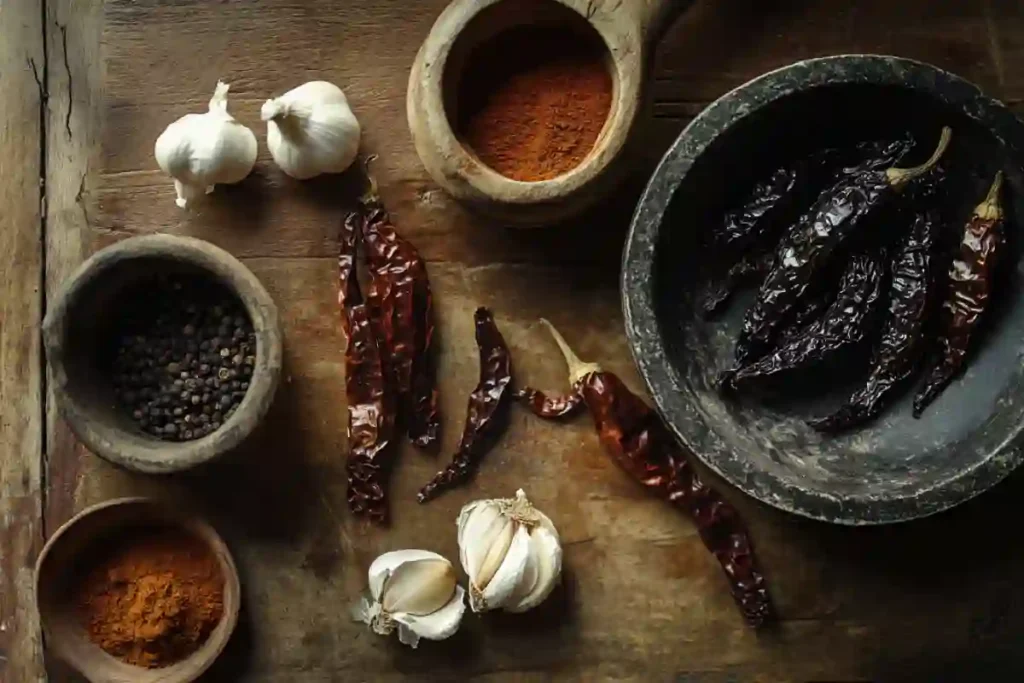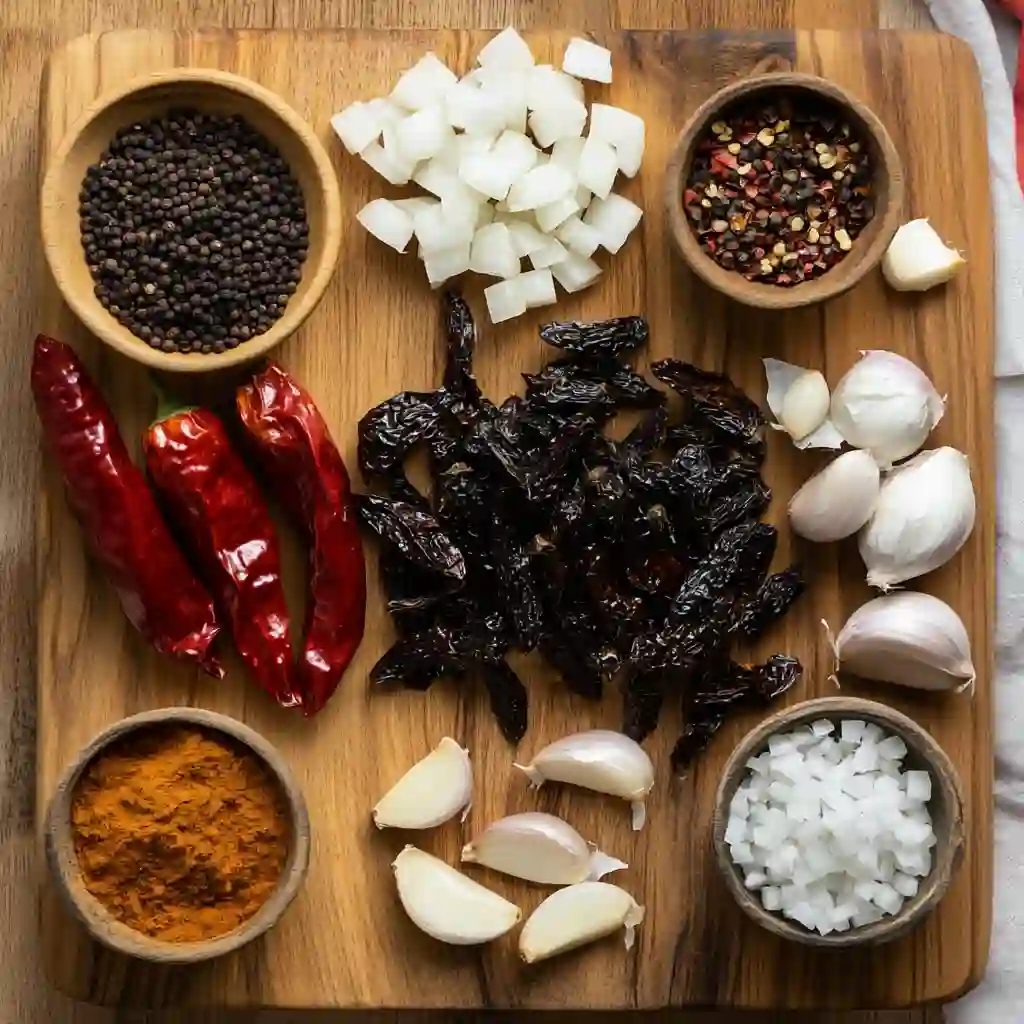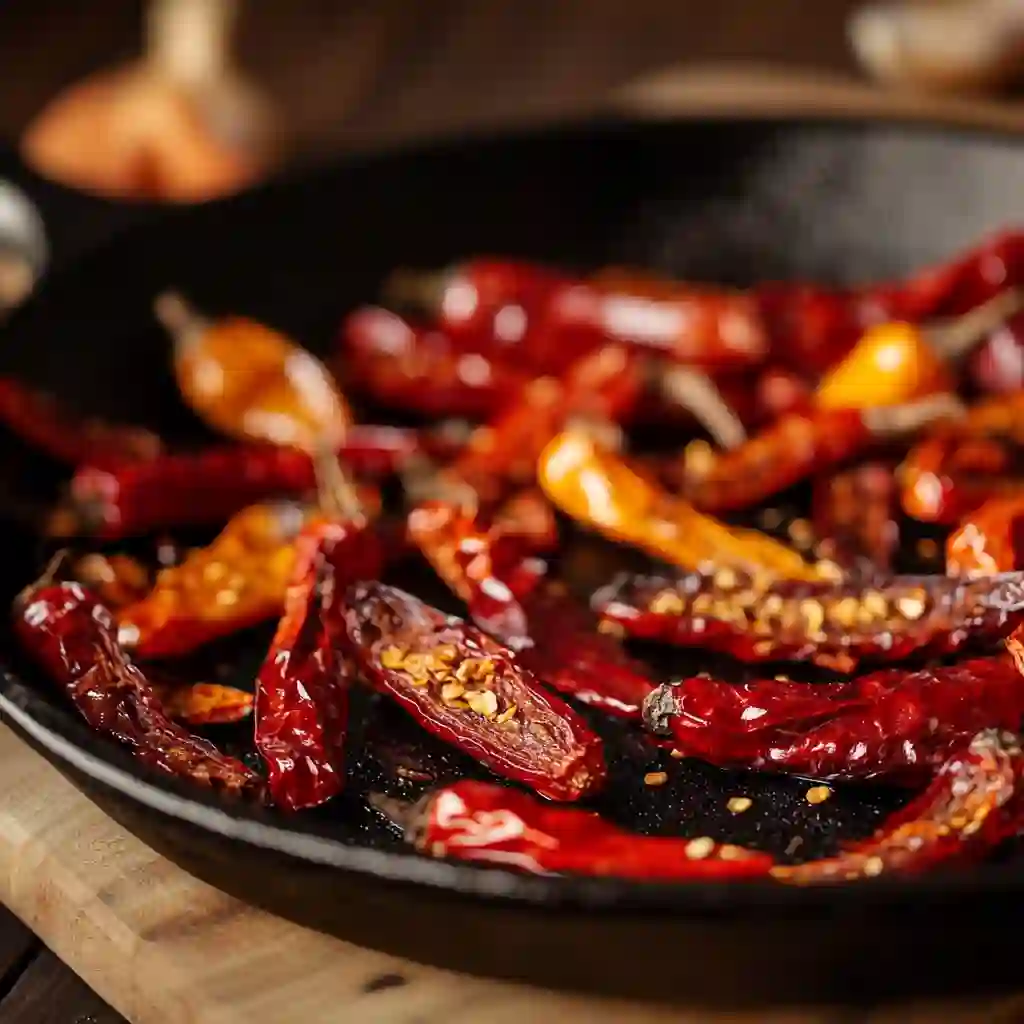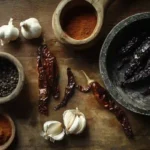
Table of Contents
There’s something magical about working with dried chilies. The way they transform a dish with just a quick toast and soak feels almost alchemical. In this article, we’re diving deep into the world of dried ancho and pasilla pepper recipes—those rich, earthy staples of authentic Mexican cooking. Whether you’re craving a smoky chili base or a subtly sweet mole, these peppers are key. We’ll walk through personal stories, cooking techniques, and simple recipes that bring out the best in these bold ingredients. Along the way, we’ll answer your top questions, and you’ll discover fresh ways to love these pantry gems.
Dried Ancho and Pasilla Peppers in Everyday Cooking
From Farm to Flavor—My Introduction to Dried Ancho and Pasilla Pepper Recipes
Growing up, I was more familiar with bell peppers and jalapeños than I was with the dried kind. That changed the day I visited my friend’s abuela in Southern California. Her kitchen smelled like history—warm, sweet, smoky. The secret? A simmering pot of black bean soup made with rehydrated dried ancho peppers. She handed me a tortilla and said, “Here. Taste.” That first bite was deep and layered, almost raisin-like with a cocoa finish. I was hooked.
I began using dried ancho and pasilla peppers in my own kitchen, starting with soups and eventually expanding to enchiladas, sauces, and even tamales. These peppers aren’t just about heat—they’re about depth. Ancho peppers, the dried version of poblano, offer mild spice with fruity undertones, while pasilla peppers (often confused with anchos) bring a slightly bitter, smoky-sweet taste that works beautifully in slow-cooked dishes.
Over time, my collection of dried ancho and pasilla pepper recipes grew—from traditional black bean chili to plant-based mole, smoky dressings, and more. In one of my go-to chili recipes, I combine both peppers with roasted tomatoes, garlic, and cumin to create a base that’s as good on its own as it is over quinoa or baked sweet potatoes. Their versatility makes them perfect for everyday cooking—just toast, soak, and blend. If you’re just getting started with dried ancho and pasilla pepper recipes, this chili is the one to try first.
Pantry Staples with Culinary Punch
Anchos and pasillas deserve more space in your spice drawer—or better yet, your pantry bin. They keep for months when stored in airtight containers, and once rehydrated, they’re as close to fresh as dried food gets. If you’re just starting out, use them in place of tomato paste or roasted peppers to add richness to sauces.
One thing I recommend: get to know the difference between the two peppers. You’ll find more on the Pasilla Bajio Chili Pepper here—a variety that’s prized for its subtle heat and aromatic depth. When used in tandem with ancho, the combination builds a flavor base that’s rich enough to carry a dish all by itself.
This pairing works wonders in sauces. I often puree soaked chiles with a little apple cider vinegar and smoked paprika to create a velvety enchilada base that can also double as a marinade. When I want something quick and comforting, I use them in soups—imagine a smoky lentil stew that feels like a hug on a rainy day.
For those who want more technical guidance on how to prepare and cook with these chiles, Isabele at shas an excellent overview that walks you through the process: How to Cook With Dried Chiles.
Deep Roots: Traditional Recipes Using Dried Ancho and Pasilla Peppers
Mole: A Timeless Fusion of Earth, Heat, and Sweet
My first attempt at mole was humbling. I remember stirring endlessly, second-guessing the bitter chocolate, and wondering if the smell of roasted chilies would ever come off my hands. But when I tasted that sauce—dark, deep, and layered—I finally understood why mole is so revered. The dried ancho and pasilla peppers brought the core of that complexity.
Mole poblano, in particular, relies heavily on both peppers. Anchos lend a mild sweetness and raisin-like richness, while pasillas bring smokiness and depth. I typically toast each chili in a dry pan until fragrant, then soak them before blending with sautéed onions, garlic, cinnamon, toasted seeds, and a touch of cacao.
If you’re collecting dried ancho and pasilla pepper recipes for your plant-based kitchen, mole deserves a top spot. It’s one of those sauces that feels ceremonial, not just culinary.
The key to a great mole is patience. The sauce should simmer slowly, developing into something both comforting and refined. I serve it with roasted veggies or pan-seared tofu, letting the mole shine without distractions.
Tamale Fillings That Speak of Home
Tamales feel like food from the soul. There’s something meditative about spreading masa on corn husks, spooning in a fragrant filling, and folding each one like a tiny gift. One of my favorite fillings involves blending soaked dried ancho and pasilla peppers with sautéed mushrooms, caramelized onions, cumin, and a dash of smoked paprika.
This flavorful blend fits seamlessly into the soft, airy masa. When steamed, the flavor deepens, and every bite becomes a pocket of umami and warmth. I’ve even experimented with sweet tamales using a mild ancho-date blend, which surprised my skeptical dinner guests in the best way.
When I want to dig into the heritage of the peppers I’m working with, I revisit that same pasilla chili profile and let its story guide the flavors I build into each recipe.
While this may not be your grandmother’s tamale, it’s one worth adding to your rotation—especially if you’re ready to trade meat for mushrooms and cream for culture.
Bold & Balanced: Cooking with Dried Ancho and Pasilla Pepper Recipes
Ingredients for Plant-Based Mole (Serves 4–6)
This is a simplified, weekday-friendly version of mole poblano using pantry ingredients and no animal products—but all the depth you expect. Use it for tacos, tamales, or roasted veggies.

Main Ingredients for Dried Ancho and Pasilla Pepper Recipes
- 2 dried ancho peppers
- 2 dried pasilla peppers
- 1 tbsp olive oil
- 1 medium yellow onion, chopped
- 3 garlic cloves, minced
- 2 tbsp pumpkin seeds (pepitas)
- 1 tbsp sesame seeds
- 1 slice whole grain bread (torn into chunks)
- 1 tsp ground cumin
- ½ tsp ground cinnamon
- ¼ tsp ground cloves
- 1 tbsp almond butter or tahini
- 1 tbsp cocoa powder
- 1 tbsp maple syrup
- 1 cup low-sodium vegetable broth (plus more as needed)
- 1 tsp apple cider vinegar
- ¼ tsp sea salt (to taste)
Step-by-Step Instructions
1. Toast and Soak the Peppers
Use kitchen scissors to remove the stems and shake out most of the seeds from your ancho and pasilla peppers. In a dry skillet over medium heat, toast the peppers for about 30 seconds per side until they puff and smell smoky—not burnt. Transfer to a bowl and cover with boiling water. Let them soak for 20 minutes.

2. Sauté the Aromatics
While the peppers soak, heat the olive oil in a pan. Add chopped onion and cook until golden, about 7 minutes. Stir in garlic, pumpkin seeds, and sesame seeds. Toast them for another 2 minutes, then add the bread chunks to absorb any flavor left in the pan.
3. Blend the Base
Drain the peppers (reserve the soaking water) and add them to a blender with the sautéed onion mixture. Add the cumin, cinnamon, cloves, almond butter, cocoa powder, maple syrup, apple cider vinegar, and ¾ cup of vegetable broth. Blend until smooth. Add more broth or soaking liquid if it’s too thick.
4. Simmer the Mole
Pour the blended sauce back into the pan. Let it simmer on low heat for 15 minutes, stirring frequently. The color will deepen and the sauce will thicken slightly. Taste and adjust with salt or a splash more vinegar if it needs brightness.
5. Serve It Right
Spoon over roasted sweet potatoes, grilled tofu, or my signature tamale filling. It also works beautifully poured over sautéed greens with quinoa.
Modern Twists on Dried Ancho and Pasilla Pepper Recipes
Batch Cooking and Meal Prep Made Flavorful
One of the best things about dried ancho and pasilla peppers is how easily they fit into a modern, plant-based kitchen. These aren’t just ingredients for elaborate weekend meals—they’re bold flavor bombs for weekday sauces, spreads, and dressings.
I often make a double batch of my smoky pepper base and use it in various ways throughout the week. It’s a smart move if you’re short on time but still want something that tastes like it simmered all day. A quick sauce of rehydrated peppers, garlic, lime juice, and soaked cashews makes the silkiest dressing for roasted veggies or grain bowls. You can even stir it into hummus for a smoky spread that turns toast into a meal.
Here’s a table of easy prep ideas that take 15 minutes or less and use dried ancho or pasilla peppers.
| Meal Prep Idea | How to Use the Peppers |
|---|---|
| Ancho Cashew Sauce | Blend soaked ancho pepper with cashews, garlic, and lime for a creamy dressing |
| Pasilla Salsa | Blend soaked pasilla pepper with fire-roasted tomatoes and cilantro |
| Pepper & Black Bean Mix | Sauté chopped pasilla in olive oil and mix with black beans and cumin |
| Ancho Tofu Marinade | Puree ancho with orange juice, garlic, and chipotle for a smoky tofu marinade |
Meal Planning with a Mexican-Inspired Pantry
If you keep dried chiles on hand, you’re halfway to dinner. One tip? Toast and grind them into powder in advance. That way, you can sprinkle their flavor into everything—soups, rubs, even salad dressings.
For an afternoon snack, I mix a pinch of ground pasilla pepper with tahini and lemon for a smoky dip. Or I add ancho powder to roasted chickpeas to snack on during the week. Once you start using these peppers like spices, your flavor range explodes.
FAQs About Dried Ancho and Pasilla Pepper Recipes
What can you make with dried ancho peppers?
You can make sauces, soups, marinades, chili bases, enchilada sauce, mole, and even dressings. They’re mild with a fruity, smoky flavor that adds depth to almost any dish.
What are dried ancho peppers used for?
Anchos are typically rehydrated and blended into sauces like mole poblano, chili, or adobo. They’re also ground into spice blends or added to bean dishes and stews.
What are pasilla ancho chiles used for?
Pasilla peppers are great for salsas, braising sauces, and slow-cooked recipes. Their rich, smoky flavor complements earthy ingredients like mushrooms and beans.
How to use dried pasilla chiles?
Toast briefly in a dry skillet, soak in hot water for 15–20 minutes, then blend into sauces or soups. You can also grind them into a fine powder to use as a seasoning.
Conclusion
Dried ancho and pasilla peppers aren’t just relics of traditional kitchens—they’re tools for modern, flavor-packed meals. From a soul-hugging mole to a creamy cashew dressing, they belong in your pantry whether you’re meal-prepping or honoring family recipes. These peppers connect us to generations of cooks while letting us write our own stories with each meal.
If you’re looking to bring more depth to your cooking, dried ancho and pasilla pepper recipes offer a beautiful entry point. They’re simple, soulful, and full of possibility.
So go ahead—toast, soak, blend, and taste. There’s no wrong way to enjoy the earthy magic of these humble, powerful chiles.
Print
Dried ancho and pasilla pepper recipes
- Total Time: 30 minutes
- Yield: 2 cups 1x
- Diet: Vegan
Description
A smoky, complex, and fully plant-based mole using dried ancho and pasilla peppers—perfect for tacos, tamales, or roasted vegetables.
Ingredients
2 dried ancho peppers
2 dried pasilla peppers
1 tbsp olive oil
1 medium yellow onion, chopped
3 garlic cloves, minced
2 tbsp pumpkin seeds
1 tbsp sesame seeds
1 slice whole grain bread, torn
1 tsp ground cumin
½ tsp ground cinnamon
¼ tsp ground cloves
1 tbsp almond butter or tahini
1 tbsp cocoa powder
1 tbsp maple syrup
1 cup vegetable broth
1 tsp apple cider vinegar
¼ tsp sea salt
Instructions
1. Toast dried peppers in a dry skillet until fragrant, then soak in hot water for 20 minutes.
2. Sauté onion, garlic, seeds, and bread in olive oil until golden.
3. Blend soaked peppers with sautéed ingredients, spices, nut butter, cocoa, vinegar, maple, and broth.
4. Simmer blended sauce over low heat for 15 minutes until thickened.
5. Adjust seasoning to taste and serve over roasted veggies, tofu, or tamales.
Notes
This mole sauce freezes beautifully for up to 2 months.
Add more broth or soaking liquid if the consistency is too thick.
Excellent base for enchiladas, grain bowls, or tamale fillings.
- Prep Time: 10 minutes
- Cook Time: 20 minutes
- Category: Sauce
- Method: Stovetop
- Cuisine: Mexican
Nutrition
- Serving Size: ¼ cup
- Calories: 90
- Sugar: 2g
- Sodium: 180mg
- Fat: 5g
- Saturated Fat: 0.5g
- Unsaturated Fat: 4g
- Trans Fat: 0g
- Carbohydrates: 8g
- Fiber: 2g
- Protein: 2g
- Cholesterol: 0mg
Keywords: dried ancho, pasilla pepper, mole, plant-based mole, vegan sauce, tamale sauce
